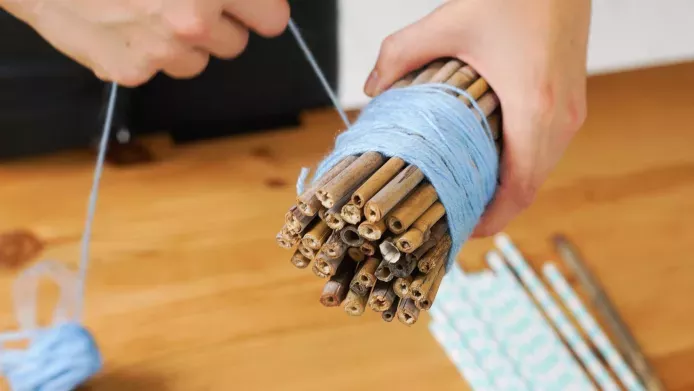When we talk about bees, what do you think of? Likely it’s hives, honey, beeswax – all related to honey bees. Because of this, it’s understandable that on hearing ‘save the bees’, beekeeping may seem like the best option for helping bee populations. But what about the wild bees?
Although there are over 20,000 species of bee worldwide there is just one species of honey bee in Europe: Apis mellifera. The species has been domesticated across the globe for pollinating food crops and producing nutritional and medicinal materials such as honey and beeswax.
The domestication of honey bees means they are not of conservation concern, whilst many other wild bees still need our help. In the UK alone there are 275 species of bee, including 24 bumblebee species and 240 species of solitary bee.
 There is just one species of honey bee in Europe
There is just one species of honey bee in Europe
Wild bees are in decline
Wild bees are particularly threatened in urban environments due to a lack of nectar-producing plants and high competition amongst pollinators. A healthy and diverse bee population is vital to supporting city trees and pollinating nearby crops.
Almost one in ten wild bee species face extinction (European Red List of Bees), including many of Britain’s remaining bumblebees.
The number of pollinators in the UK has decreased by 18% on average since 1970
State of Nature Report 2023.
 A male red mason bee, Osmia bicornis. Red mason bees can be much more efficient at pollinating apple blossoms than honey bees
A male red mason bee, Osmia bicornis. Red mason bees can be much more efficient at pollinating apple blossoms than honey bees
Bees are vital for pollinating wild and domesticated plants, including staple foods such as strawberries and tomatoes. While domesticated honey bees can pollinate many crops, wild bees are often more efficient: the red mason bee, for example, can be much more efficient at pollinating apple blossoms than honey bees. Mason bees forage at lower temperatures, in light rain and when it's windy, leading to a more uniform and consistent pollination service than that provided by honey bees.
Unintended consequences of beekeeping

Sadly, the good intentions of keeping bees may inadvertently have a negative effect on local biodiversity by increasing local honey bee populations in unsuitable locations.
It is important to promote and protect a diverse range of plant and pollinator species to maintain healthy and resilient ecosystems. Although more bees means more pollinators, it also creates unnecessary competition for nectar. When there aren’t enough plants in an area to support the local pollinator population, such as in urban areas, domesticated bees can out-compete wild bees.
Honey bees can get nectar from many types of flowering plants, whereas many wild bees rely on more limited plants for food, so are easily outcompeted by domesticated bees.
“Campaigns encouraging people to save bees have resulted in an unsustainable proliferation in urban beekeeping. This approach only saves one species of bee, the honey bee, with no regard for how honey bees interact with other, native, bee species.”
The State of the World's Plants and Fungi report, 2020.
Can I still keep honey bees?

Beekeeping is a wonderful pastime that provides human wellbeing benefits in addition to pollinators. However, when considering introducing a hive of domesticated honey bees to a new area (particularly an urban area), be mindful of protecting wild pollinators. Make sure to register with the National Bee Unit, and always consider:
- Where is the beehive? Bee hives should not be placed in areas near wildflower areas that wild pollinators rely on, such as near nature reserves or protected sites. Check with the British Beekeepers Association to see if the location for your potential beehive is suitable and that it won’t threaten rarer wild bees.
- Where is the food? More bees = more nectar needed! If possible, plant a range of native flowering plants to provide different flower structures for various pollinators. Where there is a honey bee hive nearby, make sure to up the planting! For plants to grow for bees, see below.
- How will you keep bees healthy? Always follow the National Bee Unit’s healthy bee guidelines, and seek advice from your local Beekeeping Association, to reduce the risk of honey bees passing diseases to wild bee communities.
- Stay up to date with research. The effects of beekeeping on wild pollinators are complicated and it's important to stay up to date with how to protect rare and declining pollinator species.
- Spread awareness. Share information about the diversity of pollinators, why it is important for food production and healthy ecosystems.
Why are UK native plants important for wild bees?
Many pollinators have co-evolved with UK native flowers, relying on them for food and survival. Some bee species rely on only a single or small number of plants for food.
For example, white-tailed bumblebees (Bombus lucorum) rely on short, open flowers to gather food, like clover, knapweed, scabious, comfrey, and dandelion. Or the Ivy bee (Colletes hederae) feeds on late flowering ivy which also provides good late season forage for honey bees and many other pollinators including hoverflies, wasps, moths and butterflies.
Professor Phil Stevenson from the Royal Botanic Gardens, Kew explains:
“Some bees are ‘oligolectic’, which means they feed on pollen of just a few species, often within the same genus, which exposes them to greater risk of starvation if their host plant is not available. [...] In Europe, most oligolectic species forage on native herbaceous plants, so promoting these plant species is important.”

Get growing for bees!
Here are some examples of UK native plants that support wild bee species.
A beekeeper’s favourite, bird’s foot-trefoil is a common meadow wildflower. The name refers to its hooked seedpods, which look like a bird’s foot.

Blackthorn blossoms beautifully in early spring. Its blue-black fruits are what bring us sloe-gin.
An early nectar source for pollinators, a foodplant for many moth caterpillars, and providing delicious seeds for birds, alder is a wildlife favourite. It is found in swampy conditions, where it’s wood is strengthened by a bit of water-logging.
Also known as lesser knapweed, Centaurea nigra is recognisable for its thistle-like, purple blooms. Great for pollinators, but also their seed heads provide food for birds.
White daisy-like flowers appear on this plant from late May to September.

It’s not the most elegant of plant names - thought to derive from the old English for cow dung - but its delicate nodding yellow flowers are still a welcome sight in open grassland, and increasingly on roadsides, where it's been reintroduced.
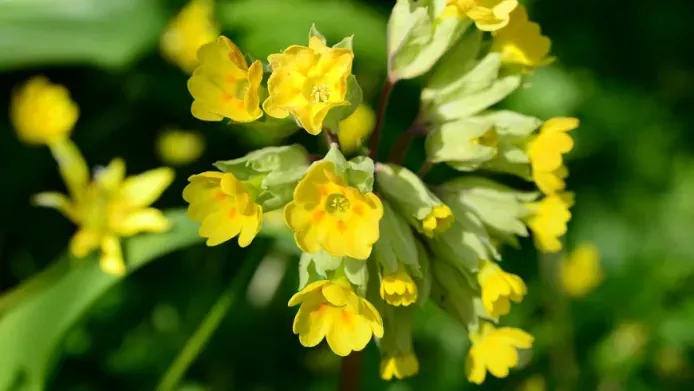
The ancestor of our cultivated apple trees, in spring crab apple displays stunning blossoms which range in colour from white to deep pink depending on the plant. It is an important food source for wildlife, including caterpillars, bees, birds, blackbirds, thrushes and mammals such as mice and voles. The fruit can also be enjoyed by humans by making jellies and wines, however they are generally too tart to be eaten raw.

The yellow florets (tiny flowers) of dandelions appear in spring as an important early nectar source. For centuries different cultures have used dandelions (Taraxacum officinale) in food and in medicine, recognising its nutritional value and appreciating its flavour.
There are two types of native dead nettle: red (Lamium purpureum) and white (Lamium album). They flower for long periods right into the autumn.

50% of the global population of bluebells is found in the UK, but they are sadly declining. Native bluebells are a protected species, so it is illegal to pick or dig them up.
This smallish maple tree grows near hedgerows, scrub and woodland edges, native to England and Wales. It is increasingly grown in urban areas as it is tolerant to pollution. The sap from this tree can also be made into maple syrup.
Hazel is a small, shrubby tree often found in woodlands, hedgerows and gardens and often coppiced (cutting of the stems to allow for new growth). It is famous for its long, yellow, male catkins in spring, and its hazelnuts that appear in late summer.
Hawthorn produces fruit and flowers reliably each year, so is a good choice to encourage wildlife. It is also low maintenance and easy to keep small. It often hybridises with the UK’s other native hawthorn, Midland hawthorn (Crataegus laevigata).
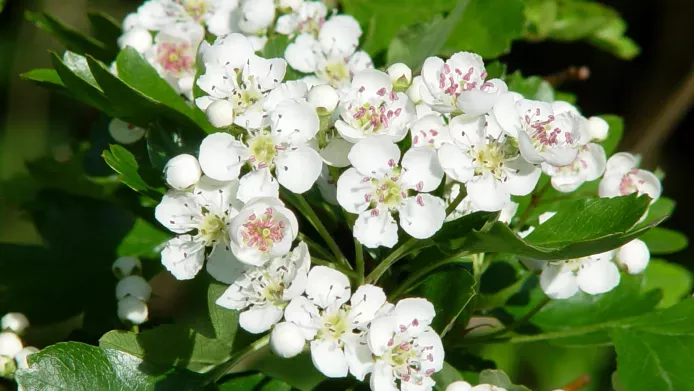
Scientists have discovered that the medicinal properties of heather nectar protect bumblebees from disease.
Heather is found on heathland, moorland, and bogs across the British Isles. However, heathlands are increasingly threatened, so the benefits of heather to bumblebees could be dwindling.

A hardy evergreen found across the UK from forests to cities. Ivy flowers between September to November.
Contrary to popular belief, ivy causes no harm to trees, but supports at least 50 species of wildlife.
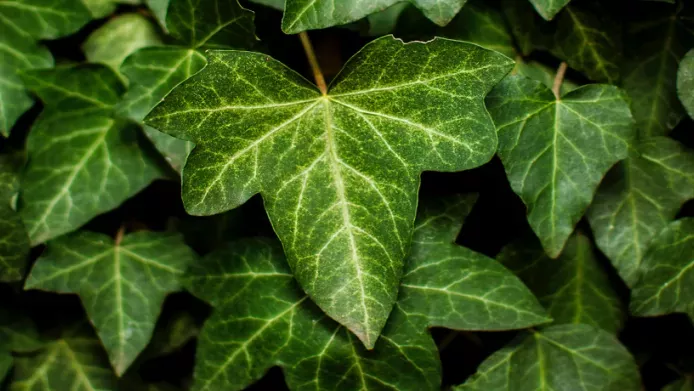
Also known as woodbine, the UK’s native honeysuckle is adored by bumblebees and other rare and declining insects including the white admiral butterfly.
You’ll spot these bigger, taller versions of the little daisies we make daisy-chains with on lawns from June to August.

Primrose is an early nectar source for bees as well as being a foodplant of the caterpillars of the rare Duke of Burgundy butterfly, which is a Priority Species under the UK Post-2010 Biodiversity Framework.

Goat willow catkins appear in spring, offering nectar for early pollinators. The male catkins look like furry cat paws! This striking tree is a foodplant for the purple emperor butterfly, as well as numerous moth caterpillars.
A good choice if you’re looking to bring some vivid pink colour to a shady area with moist soil.
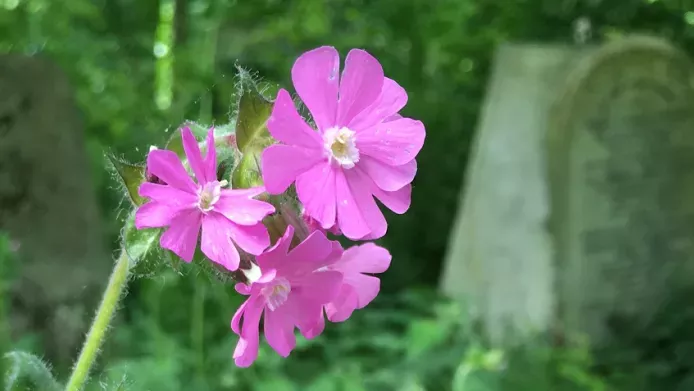
This wildflower got its name from its use as a theraputic plant – its leaves were crushed and used to dress skin wounds and syrup made with the flowers and leaves was thought to cure sore throats. The purple-blue flowers are great for pollinators.

Loved by pollinating insects and farm animals alike, white clover has been sown by farmers for hundreds of years.
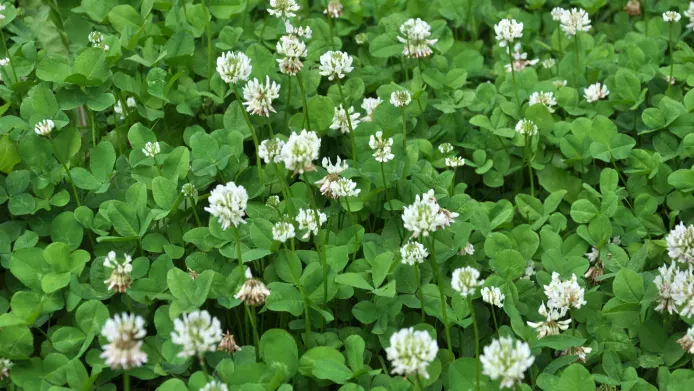
The roots of a wild carrot smell of carrots, but, unlike the cultivated ones, are thin, wiry and woody.

A beauty offering bright red charries, wild cherry flowers in April. In Scotland, cherry is sometimes known as ‘gean’.
Other ways to help bees
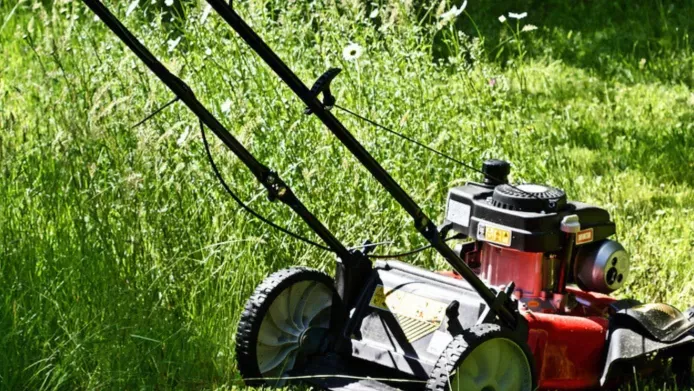
Bosch J, Kemp WP. (1999). Exceptional cherry production in an orchard pollinated with blue orchard bees. Bee World. Available at: 10.1080/0005772X.1999.11099452. [Google Scholar]
Bumblebee Conservation Trust. (2021) Position Statement on Honeybees. Available at: https://www.bumblebeeconservation.org/managed-honeybees/
European Commission, Directorate-General for Environment, De Meulemeester, T., Dehon, M., Michez, D. et al. (2014). European red list of bees, Available at: https://data.europa.eu/doi/10.2779/51181
National Bee Unit. (2020). Healthy Bee Plan 2030. Available at: https://www.nationalbeeunit.com/bee-health-improvement/the-healthy-bees-plan-2030/
Ropars L, Dajoz I, Fontaine C, et al. (2019). Wild pollinator activity negatively related to honey bee colony densities in urban context. PLOS. Available at: https://doi.org/10.1371/journal.pone.0222316
Royal Botanic Gardens, Kew. (2020). State of the World's Plants and Fungi. Available at: https://www.kew.org/science/state-of-the-worlds-plants-and-fungi
Stevenson et al. (2020). The state of the world’s urban ecosystems: What can we learn from trees, fungi and bees? Plants, People, Planet. Available at: https://doi.org/10.1002/ppp3.10143
Vincens N, Bosch J. (2000). Weather-dependent pollinator activity in an apple orchard, with special reference to Osmia cornuta and Apis mellifera (Hymenoptera: Megachilidae and Apidae). Environmental Entomology. Available at: 10.1603/0046-225X-29.3.413.[Google Scholar]
Visick, O. D., & Ratnieks, F. L. W. (2023). Density of wild honey bee, Apis mellifera, colonies worldwide. Ecology and Evolution, 13, Available at: https://doi.org/10.1002/ece3.10609


